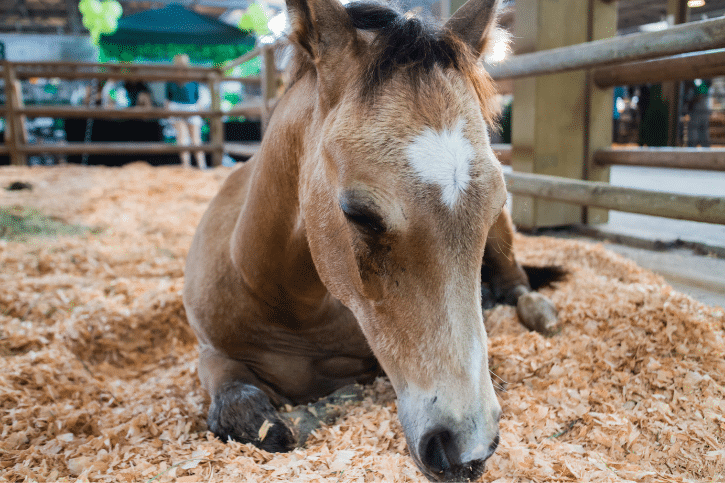Do Horses Dream?
The other day I was at a horse show and couldn’t help but marvel at how majestic and powerful all the competitors were.
These horses were able to fly over jumps that were as tall as I am.
After the show ended, I had the chance to go and talk to some of the riders, which I found thrilling!
I couldn’t wait to ask them how they could train these massive animals to move so nimbly.
As I spoke with a young lady, I noticed her horse was asleep and that got me thinking, do horses dream like humans do?
Yes, horses dream, just like people. When a horse sleeps, it experiences multiple periods of Rapid Eye Movement or REM sleep phases. During this time, horses’ brains exhibit signs of wakefulness, including increased heart rate, even though they are in the deepest level of sleep. Knowing that horses dream raises the question, “how and what do they dream about.”
In this article, we are going to take a look at whether horses dream or not, if they have nightmares and much more!
Let’s not waste any more time and get right into it!
How Do Horses Dream?
To know how horses dream, you must first understand how horses sleep.
A horse’s sleep cycle is the same as a person’s, exhibiting four stages that last varying amounts of time.
The first stage is wakefulness, where the horse is going about its day as usual.
The second stage is drowsiness which, just as in humans, lasts the most extended amount of time.
During the drowsy phase you may notice your horse has become lackluster and is no longer moving around as much as in the wakefulness stage.
The third stage is known as slow sleep wave.
Although considered a level of deep sleep, there is very little active brain activity, but this stage is vital to your horse feeling refreshed and awake later on.
The fourth and final stage of sleep your horse experiences is called Rapid Eye Movement or REM.
Your horse will experience increased heart rates, brain activity similar to wakefulness, and muscle and eye movements during this phase and may even produce an audible whiney.
The brain activity experienced during REM sleep is what gives your horse the ability to dream.
Just as in humans, horses can process information during this time, which leads scientists to believe they can see visual pictures and act out specific experiences.
Documentation of different horses “running” during REM sleep and using vocalizations and snorts help validate these scientific claims.
What Do Horses Dream About?
Although scientists can verify a horse’s ability to dream, they cannot know what they dream about.
Using the data available of what horses’ brain waves look like during wakefulness and their ability to understand and follow tasks, there is a chance horses re-enact their experiences during the day.
It is also an assumption that based on their ability to remember faces and commands, they may dream of their “memories.”
Horses have been documented during REM sleep, acting out different movements.
These motions included moving their legs as though they were running, flinging their head, and whipping their tail.
There is also documentation of them making vocalizations, including high-pitched whinnying and snorts.
Since horses can’t tell us what they dream about, it is fun to imagine based on their sleep movements what it is they are seeing and experiencing.
Can Horses Have Nightmares?
Since we can deduce that horses dream, it is logical to assume they can have nightmares as well.
The best way to determine if your horse is having a nightmare is by its actions and demeanor while dreaming.
If they act panicky, with jerky motions and alarmed vocalizations, they may be experiencing a nightmare.
Although this can be disturbing to watch, nightmares don’t cause your horse any harm and don’t appear to have a lasting effect once they wake up.
How Long Do My Horses Dreams Last?
Horses require far less sleep than humans, sometimes just three to five hours a night.
Since they’re not sleeping as long, the length of REM sleep will be shorter as well.
On average, a horse has about thirty minutes a night of REM sleep, during which they will dream.
In addition to the time they spend sleeping during the night, horses will constantly nap throughout the day, often only for three to five minutes.
Although these nap periods are short, your horse may still experience an abbreviated REM cycle.
Can Horses Dream Standing Up?
Although domesticated, horses are still prey animals, and the corresponding behavior is seen in their actions today.
Horses can sleep while standing by locking their legs, which allows them to relax their muscles without falling over.
They do this to ensure a quick escape if attacked.
They can also sleep with their eyes either fully or semi-open.
Since horses can sleep while standing, they are also able to dream while in the standing position.
If you notice your horse’s head lowered and his eyes are slightly closed, chances are he’s sleeping.
Pay attention; you may spot it when he is in REM sleep.
Horses are incredibly intelligent animals and can reason, and problem solve like humans to a certain extent.
They also have the same phases and cycles of sleep as we do.
Since they experience Rapid Eye Movement or REM phases, horses can dream.
Although only lasting around thirty minutes, REM, the deepest level of sleep, is vital for a horse’s health and well-being.
You may be able to spot when your horse has a dream by their movements, which can include a running motion, flinging their head, and tail whishing, as well as vocalizations like whinnying.
It’s impossible to know what a horse is dreaming, but they may re-enact parts of their day or memories.
They may also have harmless nightmares.
Whether laying down or standing up while sleeping, horses can and do dream.
